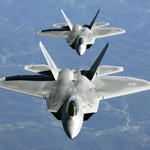F-22 Raptor hits Mach 1.5 on biofuel

The U.S. Air Force’s goal of acquiring 50 percent of its domestic aviation fuel via alternative fuel blends derived from domestic sources by 2016 got a boost on Friday March 18, when an F-22 Raptor was successfully flown at speeds of up to Mach 1.5 on a 50/50 fuel blend of conventional petroleum-based JP-8 (Jet Propellant) and biofuel derived from an inedible plant called camelina. The flight capped off a series of ground and flight tests carried out earlier in the week for the Raptor using the biofuel blend to evaluate its suitability in the F-22 weapons system.
Testing consisted of air starts, operability and performance at different speeds and altitudes. The test flight saw the F-22 Raptor perform several maneuvers, including a supercruise (a supersonic flight without using the engine’s afterburner) at 40,000 feet reaching speeds of Mach 1.5.
“The F-22 flew on Friday, March 18 and performed flawlessly on the biofuel blend citing no noticeable differences from traditional JP-8,” said Jeff Braun, director of the Air Force’sAlternative Fuels Certification Division.
The biofuel was derived from camelina sativa, a member of the mustard family and a distant relative to canola. It is a fast growing crop that can survive on little water and requires less fertilizer than many other crops. Studies have shown that camelina-based jet fuel reduces carbon emissions by around 80 percent. Additionally, its meal – what is left after oil has been extracted from the seed – has been approved by the USDA for livestock and poultry feed.
Camelina-derived synthetic fuel has been used to power a variety of military and commercial aircraft, including Europe’s first biofuel-powered passenger flight in 2009. It falls into a class of hydroprocessed blended biofuels known as hydrotreated renewable jet fuels (HRJs) that can be derived from a variety of plant oil and animal fat feedstocks.
In February, Air Force officials certified its entire C-17 Globemaster III fleet for unrestricted flight operations using the HRJ biofuel blend. The success of the F-22 Raptor biofuel-powered flight suggests further similar certifications won’t be far behind.